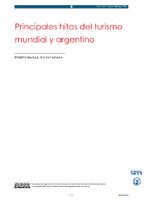Principales hitos del turismo mundial y argentino
Abstract
El presente texto, expone momentos históricos relacionados con los motivos, formas de viajar y hacer turismo, así como quienes lo practicaron. Esta breve evolución del Turismo en el mundo, y también en Argentina, se organiza a partir de cinco puntos de inflexión que explican cómo se originó, consolidó y reestructuró el sector, a medida que la humanidad comenzó a desplazarse. El primero de ellos, es en el período Neolítico en el que los desplazamientos humanos se transforman a partir de la consolidación de la vida sedentaria. El segundo punto de inflexión, se desarrolla en el Imperio Romano durante el gobierno de Octavio Augusto, en el que se logran identificar todos los elementos constitutivos de la actividad turística, a partir de los usos del tiempo libre del pueblo romano. El Iluminismo y la Revolución Industrial, durante el Siglo XVIII, desencadenarán el tercer hito, en el que quedará establecido el escenario donde surge el Turismo tal y como lo conocemos hoy. El mismo, es conocido como la práctica del Grand Tour, que no solo impactará en la distribución del tiempo libre y del trabajo sino también, en el desplazamiento del hombre. El cuarto punto de inflexión, conocido como Boom turístico, introduce el rasgo de masividad en el mercado turístico mundial a partir de la década del 50 hasta nuestros días. Los 70´ serán el comienzo de la innovación tecnológica y consecuente quinto punto de inflexión en la historia del turismo. Pese a la crisis energética mundial, el turismo internacional crecerá como nunca lo había hecho en toda su historia. Más tarde, hacia fines de los 90´ y como consecuencia, se asistirá al “fin del turismo”; enunciando el declive del turismo masivo para dar nacimiento, en la posmodernidad, al posturismo. This text sets out historical moments related to the reasons, ways of travel and tourism, as well as those who practiced it. This brief evolution of Tourism in the world, and also in Argentina, is organized in five turning points that explain how the sector originated, consolidated and restructurzed, as humanity began to move around the world. The first is in the Neolithic period, in which human displacements are transformed from the consolidation of sedentary life. The second turning point takes place in the Roman Empire during the rule of Octavian Augustus, in which all the constituent elements of tourist activity are identified from the organization of the free time of the Roman people. Enlightenment and the Industrial Revolution, during the eighteenth century, will trigger the third milestone, in which the scenario where Tourism arises will be established as we know it today. It is known as the practice of the Grand Tour, which will not only impact the distribution of free time and work but also on the displacement of man. The fourth turning point, known as the Tourist Boom, introduces the trait of massiveness into the global tourism market from the 1950s to the present day. The 70' will be the beginning of technological innovation and consequent fifth turning point in the history of tourism. Despite the global energy crisis, international tourism will grow like never before in its entire history. Later, towards the end of the 1990s and as a result, the "end of tourism" will be attended; enunciating the decline of mass tourism to give birth, in postmodernity, to post-tourism. O presente texto expõe momentos históricos relacionados com os motivos, formas de viajar e fazer turismo, bem como aqueles que o praticaram. Esta breve evolução do Turismo no mundo, e também na Argentina, se organiza a partir de cinco pontos de inflexão que explicam como se originou, consolidou e reestruturou o setor, à medida que a humanidade começou a se deslocar. O primeiro deles, é no período Neolítico em que os deslocamentos humanos se transformam a partir da consolidação da vida sedentária. O segundo ponto de inflexão, desenvolve-se no Império Romano durante o governo de Octavio Augusto, no qual se conseguem identificar todos os elementos constitutivos da atividade turística, a partir dos usos do tempo livre do povo romano. O iluminismo e a Revolução Industrial, durante o século XVIII, desencadearão o terceiro marco, no qual ficara estabelecido o cenário onde surge o turismo tal como o conhecemos hoje. O mesmo, é conhecido como a prática do Grand Tour, que não só impactará na distribuição do tempo livre e do trabalho, mas também, no deslocamento do homem. O quarto ponto de inflexão, conhecido como Boom turístico, introduz a característica de massividade no mercado turístico mundial a partir da década de 50 até aos nossos dias. Os 70 serão o início da inovação tecnológica e consequente quinto ponto de inflexão na história do turismo. Apesar da crise energética mundial, o turismo internacional crescerá como nunca havia crescido em toda sua história. Mais tarde, no final dos anos 90 e como consequência, assistiremos ao “fim do turismo” enunciando o declínio do turismo massivo para dar nascimento, na pós-modernidade, aos pós-Turismo.
Collections
- Revista Tekohá [81]
The following license files are associated with this item:



